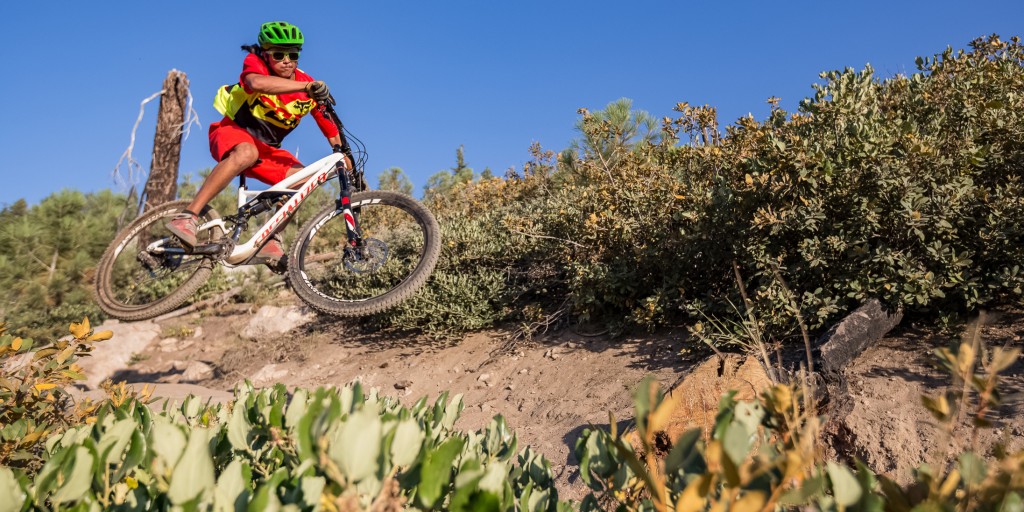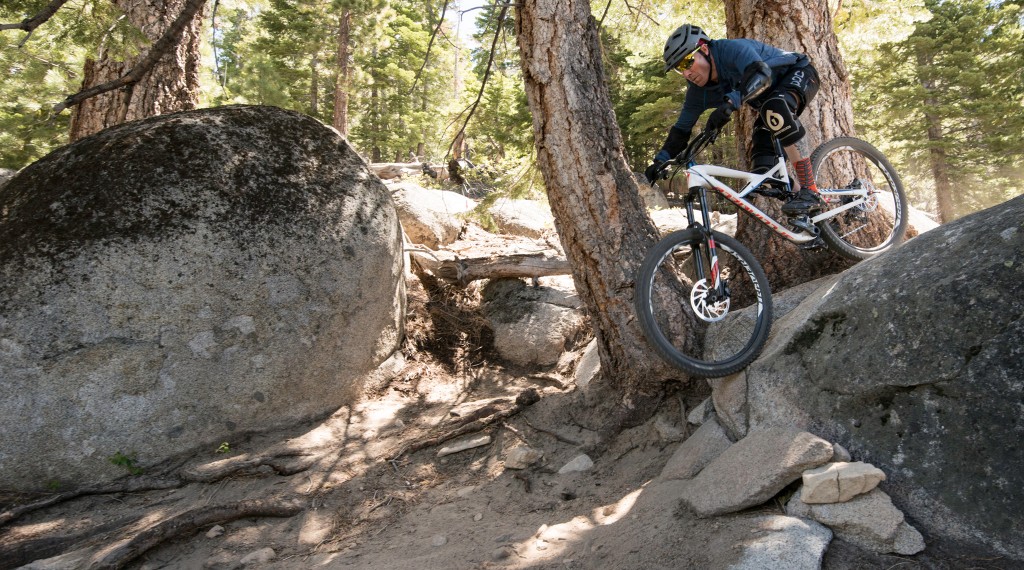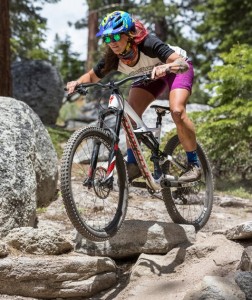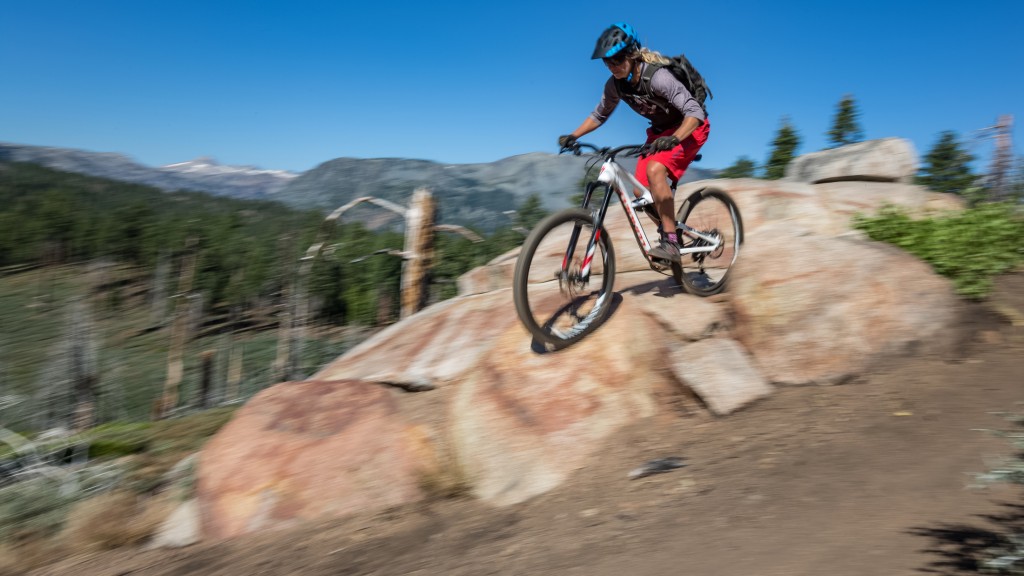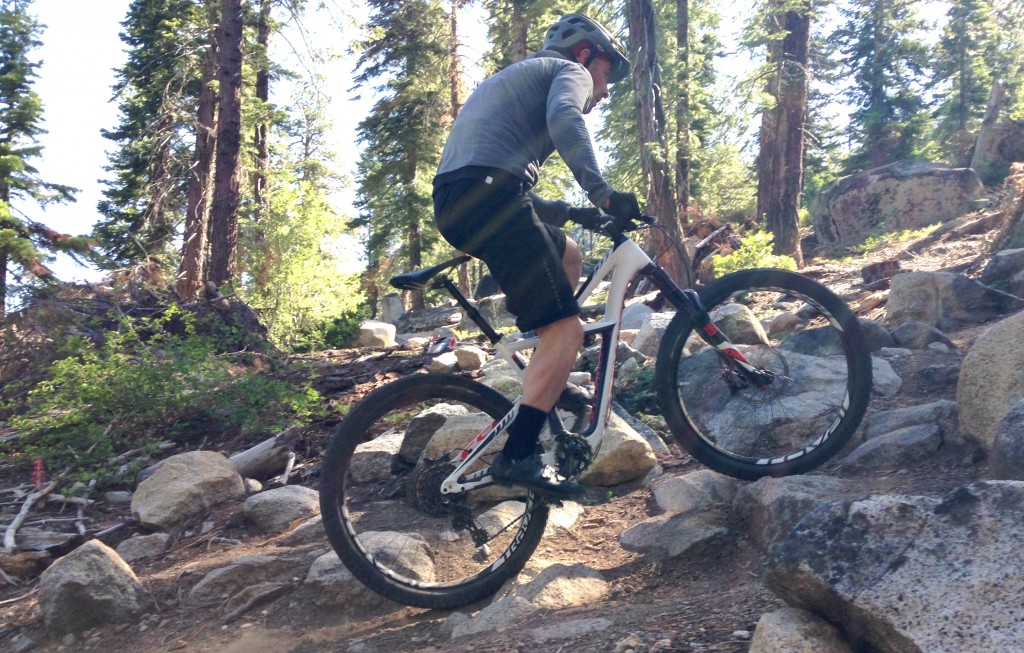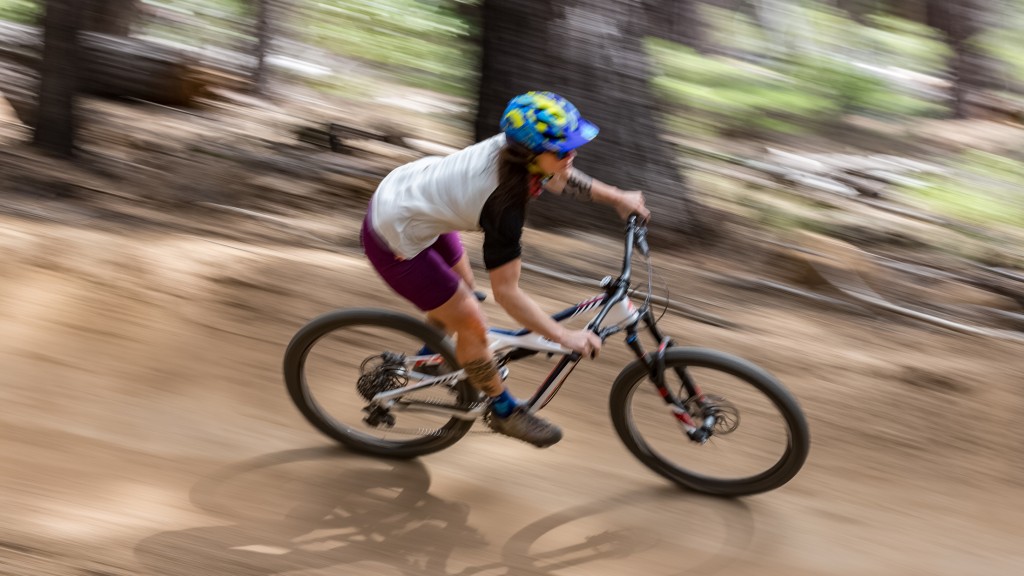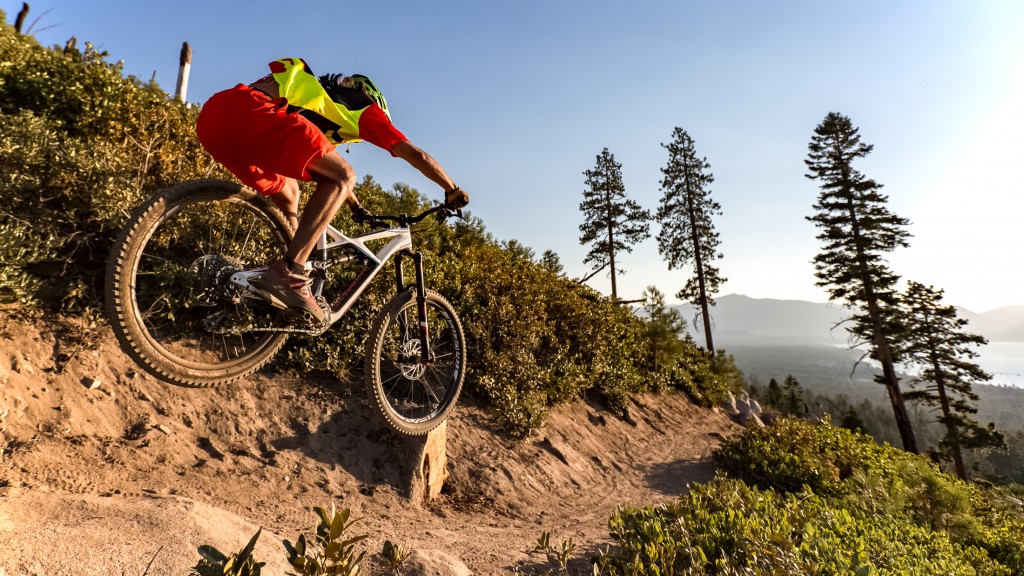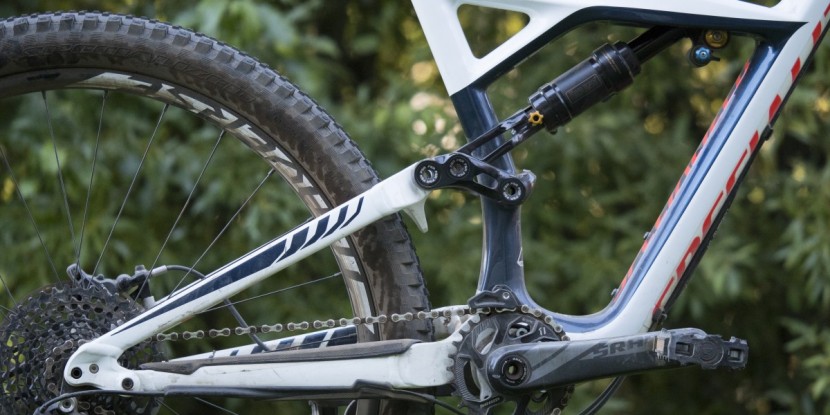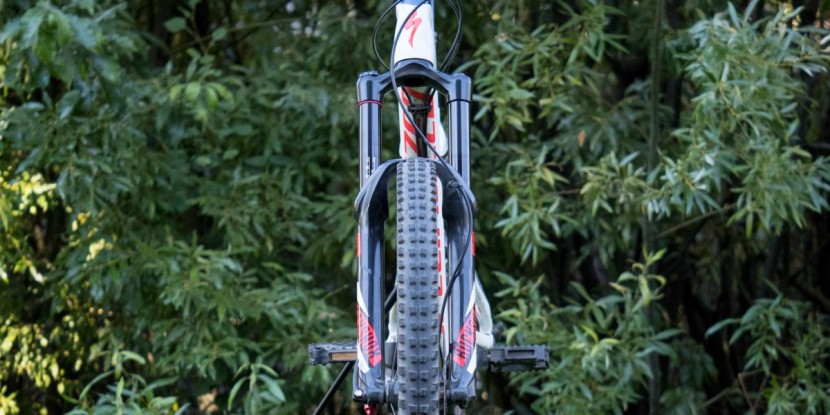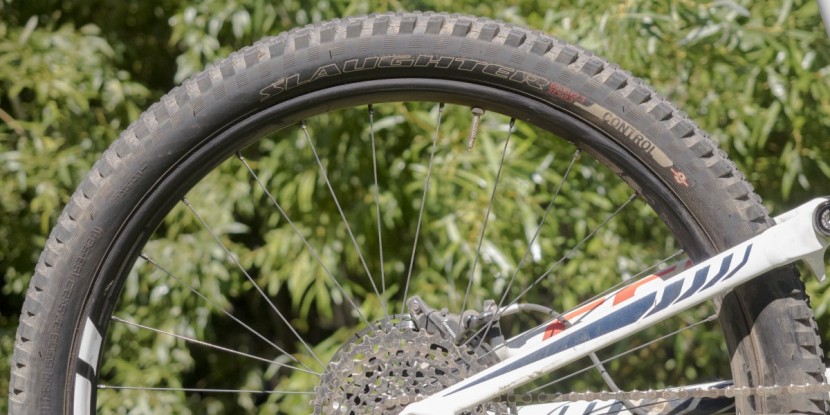Specialized Enduro Expert X01 2016 Review
Our Verdict
Our Analysis and Test Results
We put the Specialized Enduro Expert through the most extensive side-by-side MTB testing process ever conducted. We bought five of the mosy highly regarded enduro mountain bikes in the world and tested them side-by-side for two months to find out which is top enduro mountain bike. Four testers put in hundreds of miles and raced the bikes in our comparative benchmarking time trials to get our results. The Enduro faced off against the 2016 Yeti SB5.5c, 2016 Santa Cruz Nomad, 2016 Ibis Mojo HD3, and 2016 Pivot Mach 6. Find out how it did below.
Best Applications
“Smoothish, fast singletrack with, like, 300 feet of elevation gain over 11 miles,” would be a super fun ride on this bike, explains one tester. In other words, as spec'd, what the Specialized is good at is not what it is marketed for: Enduro. If we wanted an expensive commuting bike to link up smooth singletrack to get around the valley, we'd go for this bike. It's fast and maneuverable climbing abilities still make it a contender for a really climby enduro race though — when the need for speed trumps fun. That acceleration and pedaling feel can't be matched, but the feedback through the bars and the backend is annoying on the rocks and make the downhill sections feel more like a downtrodden episode of Survivor than a winning segment of The Amazing Race.
Downhill
When stepping off the Enduro Expert at the bottom of the test run, the main feeling was one of relief. A comparatively choppy suspension and skid-happy front tire had us gripping more than grinning on the downs. Technical sections were approached with trepidation - “can't wait till I get over that” - and passed with relief -"whew, glad I'm done with that" - explain two of our testers.
We conducted the majority of our tests with the Specialized as spec'd, complete with tires which we considered to be terrifyingly smooth and relatively traction-free, Specialized's Butcher Control up front, and their Slaughter Control in the rear. As a result, as tested, the Specialized Enduro was by far the worst descender of our five enduro bikes. Since it was the only bike so disproportionately affected by such an easily, and relatively cheaply, replaced component, we swapped the tires with a spare Maxxis Minion DHF 2.5" in front and Maxxis Aggressor 2.3" in rear. The difference in traction had us breathing again when taking turns, but did nothing to smooth the suspension or the swerving steering its rough ride enforces.
When we first tried out the Specialized we had it's front and rear rebound rates in their mid settings. The ride was rough. We found ourselves over the back of the bike to prepare for the inevitable big hit that would toss us forward to the middle of the cockpit. If you were already centered on the bike when that big hit came, you'd find yourself upfront and unnerved.
Lowering rebound rates help soften the jar of the stiff rear suspension but only marginally, enough to let us stay centered over the cockpit but not enough to enjoy the ride. While we kept our body pretty neutral over the bike on the flats, we still had to shift back further than normal to let the bike roll through downhill rock gardens and when cornering. The front tire might have been more effective if we had weighed it more, but, between the comparatively soft feeling fork, and the skidding tread, we were too scared.
We consider this a racey, sufferfest kind of ride. While it's not the plushest bike in the test by a long shot, it does have some considerable strengths, namely, maneuverability, agility, and pedaling power. All in all, it's a good enough climbing bike that we were willing to accept a less than ideal descent if we had a lot of upping to do.
Speed
We raced the Specialized Enduro Expert against the other four bikes in the test during our benchmark time trials to compare their relative speeds on our technical downhill course, The Scorpion. The resulting performance advantages are detailed below.
The Enduro was the second slowest descender in our benchmark time trials, clustered among the bottom three bikes. On average, it beat the Pivot Mach 6 by 0.8 seconds, but trailed the Ibis Mojo HD3 by 0.5 seconds. The Santa Cruz Nomad cruises off 2.5 seconds ahead and the Yeti SB5.5c with a full 5-second lead.
The spec'd tires are a big speed scrubbing factor for this bike. They skid out often and unexpectedly, spooking testers into taking it slow in the turns. This enforced timidity negates time gains from the Specialized's considerable acceleration skills. After the time trials, we switched the tires out for beefier versions with more traction (a Maxxis Minion DHF 2.5" in front and Maxxis Aggressor 2.3" in rear) and had all three-time trial testers take two more laps. Times were about the same, with the slower rolling tires seeming to negate gains in confidence.
Changing the tires made the bike feel much better to ride, and is something we'd recommend, but better tires didn't offer any speed advantage in our benchmark trials. The Specialized has the steepest head tube angle in the test according to its claimed measurement of 66.8°. We measured it at 66.1° with our digital angle finder, tying for the steepest in the test with the Yeti SB5.5c. Combine that with the roughest overall suspension system in the test, and the resulting squirrelly steering, and you've got a recipe for slower speeds.
Strangely, the bike felt fast to our testers, proving the importance of timing the bikes and comparatively benchmarking the results. It is the fastest accelerating bike in the test, with a cross-country pedaling feel similar to the Ibis Mojo HD3. But, unlike the Ibis, which requires constant pedaling, it holds speed well. “I think this might be the fastest bike in the test, but it is choppy, and you really have to concentrate when you're steering,” said our lead tester during testing. “It's not as easy to ride as the other bikes.” While the fast acceleration and chaotic handling felt fast, we know based on the stopwatch times that feeling of speed was an illusion; the actual downhill times were relatively slow, only 0.8 seconds ahead of last place.
Confidence
When it comes to feeling confident on the Enduro, those tires were a major roadblock. They did not inspire an iota of trust. They're meant for hard-packed soil, and may work well elsewhere, but, they hated our decomposed granite soils, and we hated them. But we went with the spec, on all the bikes. And, it's worth noting, the only other bike with tire issues was the Pivot Mach 6, and they were predictable at least. Specialized markets the Butcher Control front tire as “a tire for all mountain riders” that “excels in gnarly terrain, with fast-rolling, ramped center knobs and perfectly sized shoulder knobs that bite into the corners.” While those marketing statements might feel true on the hard-packed somewhat loamy soils (such as found in the San Francisco Bay Area where Specialized is headquartered), they certainly didn't ring true in the mountains of the Sierra Nevada where we tested the bikes. The same goes for the rear tire, the Slaughter Control. Specialized's claim that it has “tall side knobs for cornering traction” certainly didn't hold up in loose soil situations. Sure they're fast. They get you into trouble real quick, no matter the PSI. We didn't trust them nearly as far as they threw us.
Our lead tester was flabbergasted: “Not being able to trust it coming into the corner just blows my mind.” He maintains that he could have been a lot faster if he wasn't worried about the choppy suspension and tires. (Editor's Note: He pretty much always maintains that he could have gone a lot faster.) A second tester agreed. “I feel like I'm just holding back on this bike,” he said, explaining his discomfort flying downhill or entering corners at speed. The third confirms that the front tire and the choppy ride on small hits contributed to a feeling that you're not totally in control.
About that choptastic suspension: it squirreled up the steering on the descents. We voted it most likely to buck you over the bars - and this in a test against the Wile E. Coyote (i.e., trickster) fork on the Pivot Mach 6. But the Pivot's plush rear suspension kept you off its sketchy fork. And, while the back-end of the Ibis Mojo HD3 tended to toss you, its singular fork was a solid place to land, not so on the Specialized. “You could go over the bars at any moment if you weren't careful where you're body was,” says one tester.
A lot of the time we just couldn't figure this bike out. Where to be on it, how to weight the tires so they wouldn't pull the rug out, how in the name of all-that-is-enduro to dial in the bizarre suspension system. And you tend to fear what you don't understand. “I feel like when it got rough and I was going fast it was more just like 'aaahhh, I can't wait for this to be over!'” This was the only bike in the test that this particular tester crashed, or even almost crashed. (For the record, one crashed this bike and the Pivot Mach 6, and two crashed only the Pivot.) “I wouldn't take that to downhill park and ride, at all, ever.” says one tester. “It would top out and everything would explode off of it.” This is just not a comfortable or confidence inspiring downhill ride.
This stood in sharp contrast to the unshakable Santa Cruz Nomad and Yeti SB5.5c. When it comes to descending on the Santa Cruz Nomad or Yeti SB5.5c, all you hear is a chorus of “more.”- -Handling--
Happiest in tight, maneuverable terrain with minimal rocky chop, the Specialized likes to show off its snappy moves without having to bother its shocks. Its maneuverability is comparable to the Ibis Mojo HD3. It might even be more agile, but we preferred the fun and flickable nature and the amazing tune on the Ibis's boosted RockShox Pike RCT3 160mm fork.
The front end of this bike gets deflected on hits, even pretty small ones, sending you offline. One rider found himself carefully picking routes and lifting or bunny hopping the bike over obstacles, especially the bigger hits. Others just took it on the chin. Two of our riders didn't mind the shuttering steering so much, as the Specialized was capable of rolling over a lot of what was in front of it. You can certainly do that on this bike, your bones are just going to hear about it.
That spec'd front tire just doesn't track. Drift was the worst when we were in a neutral to forward position on the bike. Moving back improved the steering, and the spacious cockpit accommodated the shift comfortably. The method also had the benefit of backing off a relatively soft feeling RockShox Pike RC 160mm fork. But regardless of where we weighted the bike, we found ourselves tossed offline at least a few times. One tester describes his Specialized runs as, “a series of linked recoveries.”
When we switched out the tires the steering was much more predictable but stayed twitchy, and the suspension still shook our nerves.
- -Suspension and Traction--
There was a lot of feedback through the fork. RockShox's basic Pike RC fork that came spec'd on the bike felt inferior to both the Pike RCT3 on the Santa Cruz and its boosted iteration on the Ibis. The boosted Fox 36 Factory fork on the Yeti SB5.5c was also far superior to the Specialized's fork. The lack of a low-speed compression setting was an unwelcome surprise, the result of which was a lot of feedback through the bars. “I felt everything through the Specialized,” says our lead tester. “It just didn't feel like a big hit bike.” It feels more like a cross-country or trail bike than its namesake enduro.
When you're speeding over pedally terrain - up hills and over flats - the suspension is fine, absorbing the small chatter. But flying downhill was a shutterfest. The rear end felt similar to that of the Ibis Mojo HD3, bucky. But, unlike the Ibis, where you can take refuge by hovering over the plush front end, you have nowhere to go. The bigger hits weren't much better. Instead of sinking into the suspension coming off a drop, we felt the jarring hit and then got launched. “The rear suspension is lacking compared to the others,” says our lead tester. “It definitely feels choppier when you hit that big item, that square edge stair.”
Slowing the fork's rebound rate helps, to a degree, but there's still no comparison to the ride quality offered by the Santa Cruz Nomad or the Yeti SB5.5c. In one tester's words: “When I came up to rocky stuff with the Santa Cruz I just let it ride under you, the Specialized you get in it and you're just like 'alright, here we go, rocky stuff - guhguhguhguh.'” (Repeated jackhammer fast.)
Climbing
We had a hard time getting over the lack of lockout, and the stairs, on this bike. Sinking into the suspension with every pedal stroke, like running in sand, just does not feel efficient. But, according to our benchmark time trials, it kind of is. The Specialized produced some pretty speedy times and eventually tied the with the Santa Cruz Nomad for second place on the uphill test track. And while the Nomad's kicked-back cockpit feels a tad too relaxed to comfortably climb in all day, the Specialized sets you up in a very comfortable climbing position. For this reason, we ranked the Specialized as a better climber than the Santa Cruz. The Yeti SB5.5c wins this category.
After we came to accept its climbing quirks, we started to appreciate the Specialized's superior acceleration, low overall weight, and light pedaling feel. The Enduro is a pleasant climber, and definitely our choice, behind the Yeti SB5.5c, for a full day of climbing, as long as it's a smooth ride. Stair steps or rocky sections set the steering twitching, forcing you to fight for control. If you lose, and we lost a lot, you find yourself bounced off line and working hard to recover, that pinball feeling again.
Shifting around to optimize for body position and lifting leverage was a lot more work than the eat-rocks-for-breakfast-lunch-dinner-&-snacks Santa Cruz Nomad or Yeti SB5.5c. On the plus side, it's longer wheelbase and roomier cockpit made it easier to maneuver than the Ibis Mojo HD3 or Pivot Mach 6. Again, it's capable; it's just not optimal.- -Speed--
That means that the Specialized and Santa Cruz gain 1.2 seconds per minute on the Pivot and 1.0 second per minute on the Ibis. They are also 1.7 seconds per minute behind the Yeti. Over an hour long uphill course that translates to cutting your lap time by 1:12 min:sec if you pick the Specialized over the Pivot and by 1 min if you pick the Specialized over the Ibis. But you'd still be 1:42 min:sec behind the time you would earn on the Yeti.
Pedaling
“It pedals like a rocketship,” says one of our testers. The Specialized Enduro wins the pedal-ability contest, hands down. With the spec'd tires — those fast rolling, rider tossing conundrums — it also feels like the fastest accelerator in the test. When we switched out the factory tires for knobbier, beefier aftermarket Maxxis tires, it moved back a notch to a first-place tie with the zippy pedaling feel of the Ibis Mojo HD3.
That means that unlike the slow to accelerate Santa Cruz Nomad and Yeti SB5.5c, the Specialized gets right back up to speed after every bobble. Which is great, because there were a ton of them. And again, although the suspension doesn't lock out, no one felt an appreciable loss of energy into the pedaling. Though we would like a firmer platform. At the very least it would preserve us our sanity and ego. Bobbing isn't very hardcore.
Handling
On a climb the Santa Cruz Nomad's front tire flops and the Pivot Mach 6 wanders — the Specialized does a bit of both, making steering this twitchy machine a mixed bag. Steering was much squirrelier than the perennially stable Santa Cruz and Yeti, owing to all that chop. You definitely find yourself offline. It even out twitches the Ibis Mojo HD3 in the chop. The Ibis's far superior fork makes it much easier to hold a line. It straightens out somewhat if you can shift your weight back from the bars, quite a feat when you're standing up on the pedals and cranking through a stair climb.
Turning isn't the problem. This bike is so easy to turn that we found ourselves quickly correcting mistakes, all over the place. The front tire isn't glued down like it is on the Santa Cruz Nomad or Ibis mojo HD3. You have to finesse the bike more, while really aggressively steering towards where you want to go.
You can't just plow through the steps like you can on the Santa Cruz or the Yeti. You have to lift the front tire up and over or else absorb the full impact with your body. Getting full-body punched is only fun so many times. It's harder to recover from mistakes in these steep stretches, at least mentally, because the suspension seems to suck up any initial corrective energy. This is a lot of complaining for a bike we supposedly like to climb. It's a wonderful climber on pavement or utterly smooth trails, when handling isn't really a thing.
Suspension and Traction
The compression settings on the Öhlins Single Tube rear shock don't feel like they are doing anything. It's crazy making. Crank up the compression, up the PSI, sing a song, dance a jig - nothing. Feels pretty much the same, wide open or shut tight. In combination with Specialized's Future Shock Rear (FSR) rear suspension linkage system, which relies on its shock to stiffen up the backend and reduce pedal bob, this led to one wild ride.
It at once feels too soft for the climb — with riders' energy compressing the suspension when they're loading the bike to pop it over a stair — but too stiff and choppy for the steering to stay straight in the rocky sections. Two of our testers usually run the test bikes' compression settings in trail mode on the climb and one runs them wide open. One of the trail setting guys jumped ship to open the Specialized's compression on the climb to soften the suspension. It helped, a little.
But somehow, through it all, the Specialized still pedals well. And the system certainly kept those Specialized Butcher Control and Slaughter Control tires on the ground, giving them the option of maintaining traction. They did okay when the dirt was well packed. When it loosed up, or when we rolled over rocks, the rear tire slid out.Cornering
Taking turns on the Specialized spec'd tires was a nightmare. Residual PTSD kept us from fully appreciating the great cornering it's capable of with some decent rubber on those rims. When properly attired the bike is a solid cornerer. With the second shortest wheelbase in the test (which we measured at 1147.9 mm) it's easier to get around the tight turns than the longer Santa Cruz or Yeti. But it doesn't compare to the quick turning Pivot or Ibis, even though the Ibis is quite a bit longer (measured at 1162 mm).
The bulk of our cornering experience on the Specialized came from riding it around on the sand skates that Specialized considers all-mountain tires, which really bummed us out during benchmark testing. If you could make it from the tire's center to the side knobs, the bike cornered well even with the crap tires. Getting there however was a feat of epic bravery. We had to throw it down, placing serious trust in the biking gods while crossing a vast transition plain, capable of hurling us into whatever abyss lay on the far side of the trail. “Which is kinda sketchy,” said our lead tester. The fallout was unpredictable. If you happened to be traveling on loose gravel over firm rock, or in deep sand, just forget it. The original front tire is insanely bad in those situations. In flat corners, the tires just blow past, which does wonders for your acceleration. You'll skid out real fast. Lowering the tire pressure helped a little, but not enough to justify running those tires.
To account for the ever-present threat of blow out, we found ourselves steering the bike through the turns instead of counting on a fast lean to lead us through — slower, and way less fun. Which is a bummer, because with good tires (or great soil conditions) the Specialized leans really well, whipping through berms with aplomb. Switching the tires out for bulkier Maxxis versions (a High Roller DHF 2.5" and Aggressor 2.3") during our WTF rides made a huge difference. “I was way more comfortable cornering that thing,” said our lead tester. Taking away the skid factor did wonders for our cornering confidence. It was still tricky in the tightest and roughest turns, but we railed through the rest.
Fast and wide radius berms work great on this bike. But it can get a little twitchy in short switchbacks and it does not like rocky corners, with the rough suspension squirreling up the steering. We kept low and centered in the turns. “The bike doesn't like when your body is too far forward,” explains one tester. In any case, it's always nice to know, no matter what happened in those corners, the Specialized's speedy acceleration would let us sprint right back out of them.
Fun Factor
The Enduro erred too far on the side of performance and sacrificed on all the fun. When talking about this bike we all furrow a quizzical brow, which is so unlike the goofy, puppy love expressions we wear when discussing the Santa Cruz, Yeti or Ibis. The only time we reference this bike as fun was when we were describing its climbing prowess. “I climbed the best on that bike, but that's kind of like type II fun,” explains one tester. “That's like, proud moments fun.” We never called it playful, not once. We liked it. We'd even ride it by choice. But don't try to tell us we're having a good time.
Jumps
It's not the enthusiastic jumper either. Not one for hops or pops, it doesn't send off a lip either. We had to load it up and work to get the right angle to clear the jumps. It's not one to just sail away and it's all over the place in the air. To sum it up, one tester deadpans, “I don't love it through the jumpline.”
Race Factor
The Specialized ranks third when we combine the average times on our up and downhill time trial courses, coming in 3.4 seconds ahead of the Pivot, but 8.8 seconds behind the Yeti.
That translates to the Specialized gaining 1.6 seconds on the Pivot for every minute ridden. Again, the Yeti is way ahead with 2.9 seconds per minute on the Specialized. So, for every hour-long section of trail ridden, the Specialized will be 1:36 min:sec ahead of the Pivot, but 2:54 min:sec behind the Yeti.
Still, we would take the Specialized out for climbing centric race days where the Santa Cruz's laid-back cockpit might suck too much energy while climbing or where the slightly trickier cornering of the Yeti would be a major liability.
Build
With a house dropper post, those freaky Specialized tires and an odd, untested Öhlins rear shock - we feel like the Specialized Enduro has a good frame foundation, but that the company took too much liberty with its component choices. “There's a lot of house specs on the Specialized that, at that price range, I think people are just not going to be happy with,” says our lead tester. “They've built an ultimate trail bike, not really an enduro race machine, as a spec.”
But really it comes down to the rear shock and the tires. One of our testers rode the 2015 Specialized Enduro Expert in our last round of testing. He noted that those were the only two differences from the 2015 model to 2016, and the 2015 model felt “awesome” to ride.
Cockpit and Fit — The bike can feel large at first, partially owing to its extra wide handlebars, but is comfortable after settling in, with plenty of room to move around. It wasn't the most (i.e. Nomad) or the least (i.e. Mach 6) comfortable bike, but it feels very balanced beneath you. All of our testers, from 5'7" to 5'10", feel that the medium fits.
Frame and Suspension — The frame is pretty solid, aside from having one of the steepest head tube angles in the test (measured at 66.1°). We didn't mind the externally routed cables, and they're easier to access for repairs. Though the crisscrossed loops in the front rattle a bit. BONUS: The frame has a mount for a water bottle inside the front triangle.
The basic 160mm RockShox Pike RC fork was not cutting it. Feedback rattled up to the bars and we sorely missed the lacking low-speed compression knob. It ended up feeling more solid than the Pivot Mach 6's divey soft 160mm Factory Fox 36, but never inspired much confidence. The combination of the unfamiliar Öhlins rear shock and Specialized's Future Shock Rear (FSR) suspension system is similarly confidence shaking, bouncing us around on the rocky stuff, more than any other test bike aside from the Ibis, and refusing to stiffen up for the climbs. It functions, but we aren't in love with it.
Wheels and Tires — The Roval Traverse wheelset is a pretty solid choice and worked well throughout our test, but — as we've mentioned — the spec'd Specialized tires, Butcher Control front and Slaughter Control rear, were just bad. Meant to be light and fast rolling, they certainly are, but, on dry days, they spook us no matter where we take them on our trails, which range from decomposed granite to pine duff. Just after a rain (which we can ride due to our quickly draining soils) they held it together on tightly packed/tacky days, but otherwise they were a skidfest, providing zero traction on square stairs or rock slabs. The front tire was super squirrelly and the rear tire had minimum braking power.
Groupset — There are no shifting issues and the drivetrain works just fine, but the SRAM Trigger shifter is on the cheaper side of things. Free wheeling is minimal, meaning we can always be gaining speed on pedal strokes. The crank length seems a bit long at 175mm, but four of our five bikes are spec'd with them. They feel like overkill and we'd like to go shorter to avoid excess pedal strikes, which happened occasionally on the Specialized.
The SRAM Guide RS brake levers are a step down from the SRAM Guide RSC spec'd on the Santa Cruz, Yeti and Ibis, but are adequate.
Handlebars, Seat and Seat post — The 780mm wide Specialized handlebar felt awkwardly wide at first, but we got used to it. (Aided by the 800mm wide bars on the Santa Cruz and Yeti.) We came to the conclusion that they are a great size for the bike, if they are a little intimidating to squeeze through keyhole rock slots.
The saddle is cozy but the Specialized 120mm dropper post is a bummer. It clicks and the cable jams often, forcing you to feed it through. The remote is awesome, but like the Ohlins shock, it's a multiple personality dropper that's hard to figure out how to finagle. Which makes it annoying to dial in the perfect heights to fit your leg length. Check out our dropper post review for more seatpost intel.
Value
It's the least expensive bike in the test but we're still not stoked on the Specialized Enduro's value. We'd immediately buy a more versatile set of tires. But that isn't going to fix your problems with its suspension. “I think it's got potential to be a great bike, with some serious upgrades,” says our lead tester, suggesting upgrading the tires, fork and rear shock. At that point the value isn't looking so good. If we wanted a bike this racey that we actually enjoy riding, we'd just buy the Yeti SB5.5c.
Conclusion
The Specialized Enduro Expert performs well on most areas of the trail. Climbing is swift and effective despite the noticeably unpleasant pedal bob. Handling is reasonable aboard this burly bicycle and cornering is confident with the right rubber underneath you. The twitchy rear suspension doesn't match the aggressive feel of this bike. Aiming it through rough terrain is a choppy endeavor. Still, this bike is relatively quick even if it is not as easy-riding as some other test bikes. Swapping out the suspension would go a long way to improve the ride.



